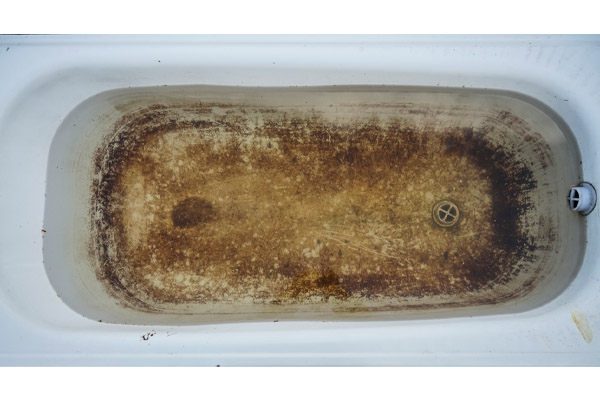Any individual will have their unique notions about What To Do If Sewage Starts Backing Up Into the Shower.

Sewer back-up in the bathtub can be a distressing and unhygienic trouble for any kind of property owner. Not only is it bothersome, however it also positions serious health and wellness risks and shows underlying problems with the plumbing system. Comprehending why sewer is coming up through the bath tub is vital for taking ideal action to resolve the issue effectively.
Intro to the Problem
Typical Reasons for Sewer Back-up
Blockages in the Drain Line
Among one of the most common reasons for sewage backup is a clog in the sewage system line. This can happen due to the build-up of debris, grease, or foreign items in the pipes, preventing proper circulation and creating sewage to back up into your bath tub.
Tree Origin Intrusion
Tree origins seeking dampness and nutrients can infiltrate sewage system lines through small fractures or joints. In time, these origins can expand and increase, triggering considerable damage to the pipes and bring about sewage back-up problems.
Understanding the Trouble
When sewage draws back up into the tub, it's a clear indication of an issue with the water drainage system. The wastewater that should be streaming far from your home is rather finding its way back right into your home, which can result in substantial damage and health hazards.
Prospective Causes
A number of factors can contribute to sewer backup in the bathtub. From clogs in the sewage system line to concerns with the plumbing infrastructure, determining the root cause is important for locating a solution.
Aging Infrastructure
Older homes may have dated plumbing systems that are extra vulnerable to corrosion, cracks, and degeneration. As pipes age, they become more vulnerable to leakages and blockages, raising the likelihood of sewage backup occurrences.
Heavy Rainfall or Flooding
During periods of heavy rainfall or flooding, the sewer system may end up being overwhelmed with excess water, creating back-ups and overflows. This can cause sewage backing up into tubs and other fixtures inside the home.
Indicators of Sewage Backup
Foul Odors
Unpleasant odors rising from drains or components, especially in the shower room, might suggest sewer backup concerns. These odors are usually strong and persistent, indicating a trouble that needs prompt interest.
Slow Draining Fixtures
Tubs, sinks, and toilets that drain pipes slowly or otherwise in any way could be experiencing sewer back-up. If numerous components are impacted simultaneously, it's most likely that the concern originates from a common factor, such as the primary drain line.
Gurgling Sounds
Strange gurgling or bubbling noises coming from drains when water is running somewhere else in your home are a measure of air trapped in the plumbing system. This air accumulation can result from sewer back-up and should be explored immediately.
Health And Wellness Threats Associated with Sewage Backup
Contamination of Water
Sewer back-up can contaminate the water in your home, presenting a serious wellness threat to you and your household. Exposure to infected water can cause gastrointestinal problems, skin infections, and various other diseases.
Mold and mildew Development
Wetness from sewer backup can produce excellent problems for mold and mildew growth in your house. Mold spores can aggravate breathing issues and cause allergies in delicate people, making timely cleaning necessary.
Spread of Condition
Sewer has hazardous microorganisms, viruses, and parasites that can cause a range of diseases, consisting of hepatitis, cholera, and gastroenteritis. Entering into contact with sewer or polluted surfaces puts you at risk of infection.
Tidying up After Sewage Backup
Sanitation Procedures
Thoroughly decontaminate and sterilize impacted areas after sewer backup to eliminate damaging germs and avoid mold development. Usage ideal cleansing items and safety gear to ensure safe and efficient cleaning.
Remediation of Affected Locations
Fix any damage to flooring, walls, or fixtures triggered by sewage back-up. Depending upon the extent of the damage, you might need to replace carpeting, drywall, or other products to recover your home to its pre-loss condition.
Immediate Actions to Take
Turning Off Water
In the event of sewer back-up, it's vital to turn off the water supply to avoid additional contamination and damages. Find the main water shutoff valve in your home and closed it off till the concern can be settled.
Contacting an Expert Plumber
Handling sewer back-up is not a do it yourself task. Contact an accredited plumber with experience in taking care of sewage-related concerns to examine the situation and do required repair services or clean-ups.
Avoiding Contact with Polluted Water
Until the sewage backup is fixed, prevent contact with infected water to prevent the spread of bacteria and virus. Put on protective equipment if you must be in the afflicted location and clean your hands completely later.
Safety nets
Regular Maintenance of Sewage System Lines
Schedule normal evaluations and maintenance of your sewage system lines to recognize and deal with prospective issues prior to they rise right into significant issues. This can include cleaning particles, checking for tree root invasion, and fixing any kind of broken pipelines.
Setting Up Backwater Shutoffs
Think about installing bayou shutoffs in your plumbing system to stop sewer from receding into your home throughout periods of heavy rainfall or flooding. These valves instantly close when water draws back up, safeguarding your residential or commercial property from contamination.
Proper Disposal of House Waste
Prevent flushing anything aside from toilet paper and human waste down the commode to prevent clogs and clogs in the drain line. Dispose of oil, oil, and various other house chemicals effectively to minimize the danger of plumbing troubles.
Why Is Water Backing Up in My Bathtub When I Flush My Toilet?
What to do about a sewer line clog
First, don’t bother with plunging. No amount of plunging will dislodge the clog in a sewer line. The clog is too far away. Plungers are for clogs in the toilet itself, not the sewer line. Plus, the most likely causes of a sewer clog are:
Tree roots Flushed toys or feminine products Grease buildup Those items don’t move easily. And in the case of tree roots, the roots need to be cut out of the pipe and the pipe will need to be repaired.
You’ll need a closet auger. A closet auger is a type of plumber’s snake with a protective cover to keep from scratching the delicate porcelain toilet. If the clog is further down, you may need to remove the toilet or use one of your cleanouts to get to the clog.
We also recommend doing a video inspection of the drain to ensure that the cause of the clog has been completely removed. Otherwise, you could have the same problem again in a few days or weeks.
https://mspplumbingheatingair.com/blog/why-is-water-backing-up-in-my-bathtub-when-i-flush-my-toilet

Hopefully you enjoyed reading our article about Why sewage is coming up through your bathtub. Thanks a lot for spending some time to read through our piece. Those who enjoyed reading our article please don't forget to pass it around. Thanks a bunch for your time. Kindly come by our site back soon.
Booking Page